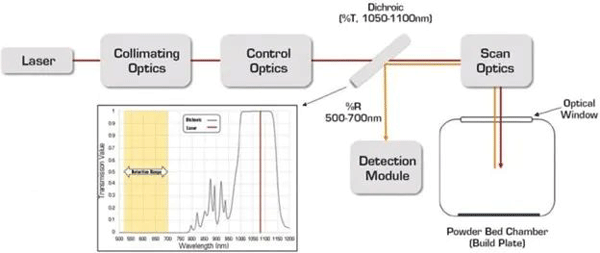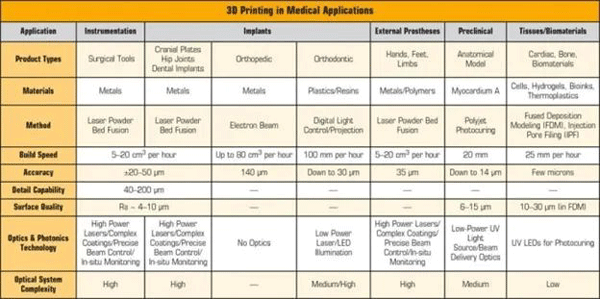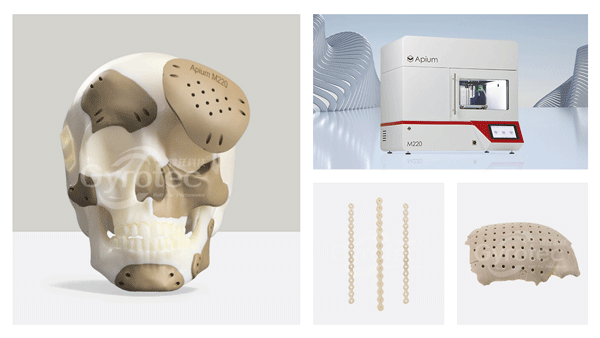Additive manufacturing (also known as 3D printing) was born in the 1980s with the initial use of UV light sources for the optical curing of polymeric resins. Over the past few decades, technological advances have enabled the fabrication of functional parts from various types of polymers, powders and even metals. 3D printing has seen an explosion of applications in several industries, particularly in the medical industry, many of which benefit from the rapid production of customized orthopedic implants for knee and hip replacement surgery. For example, dentistry is one of the medical fields where 3D printing has gained popularity, often using 3D printing technology to create highly customized crowns, bridges and braces needed for orthodontics.

▲Figure 1: The optical path of a laser bed fusion (LBPF) 3D printer, which shows all the core optical and photonic product technologies used to control and control the laser beam into
the powder chamber, as well as the detection path for real-time monitoring of the build.and the detection path for real-time optical monitoring of the build.
The inset shows the spectral profile of the dichroic optical beam splitter that directs the beam to the detection path.
(This spectrum is courtesy of Iridian Spectral Technologies)
Light is a directional form of energy that opens up a wide range of applications for 3D printing in the medical industry, allowing the use of lasers, high power LED light sources and projection optics to reliably produce high resolution features at increasingly faster production rates. In the beginning machine architects utilized off-the-shelf (OTS) optics and system components, often at the expense of partial performance. Yet the more complex the geometry, the finer the features, the higher the demands on surface finish, the greater the need for energy control and the ability to monitor and stabilize the process in the field. As a result, current and next-generation machines require highly customized optical designs to efficiently guide the beam to the work plane in a repeatable manner.
To keep industrial-grade 3D printers running consistently for hours to days, engineers face many demanding challenges in the design and selection of optics (e.g., glass type, surface shape, optical coatings, manufacturing tolerances). These machines often need to pass a rigorous certification process and meet medical implant specification standards. This paper covers a number of important technical topics worthy of engineers, including:
1、Large transfer of light beam to the powder bed
2, how to improve the precision of component manufacturing through optical components and their functions
3, the importance of all optical coatings on the optics to ensure beam efficiency
4, the importance of optical real-time closed-loop metrology for part production verification
Print resolution is a key factor driving additive manufacturing. The use of various materials such as titanium and engineering polymers to print parts at precise dimensions with defined surface finish and density characteristics can greatly reduce subsequent processing steps such as machining and polishing. This makes printing parts tailored to the patient not only faster than traditional subtractive manufacturing processes, but also allows costs to be reduced due to decentralization or deconcentration of the supply chain. Directional laser energy and projection systems are widely used in additive manufacturing optical systems as described in Table 1. With the appropriate optics, these machines can tailor the beam to obtain the desired energy distribution based on specific spot size and intensity uniformity requirements, resulting in faster build times and improved part quality.

▲Table 1: Types of 3D printers, processes and materials used in various medical metal, plastic and polymer parts production lines
The metal additive manufacturing process based on powder bed fusion technology is a typical example of how the optical components and system design determine the overall quality of a part. The basic optical layout of a laser powder bed fusion (LPBF) system is shown in Figure 1. A high-power laser source (typically a fiber laser) emits a 1 kW or higher power near-1070 nm light wave through a fiber collimator and focusing element, which is then directed to the work plane by a multi-axis scanning mirror. The quality and stability of the focused spot is directly influenced by the selected optical and mechanical components.
In processes using high power lasers, even small amounts of scattered energy should not be ignored, as they may cause drastic thermal effects inside the optics and support mechanism at the same time. Thermal expansion within the metal mechanics may cause displacement or drift of the element position, so extra attention needs to be paid to material selection and air or water cooling. There is a "thermal lensing" phenomenon inside the optics caused by the heat of the glass, which affects the lens shape and the refractive index of the material. The thermal lensing effect is a common problem at the entrance to the powder bed chamber and near the high light intensity region of the beam path. If materials and coatings are not selected properly, the thermal lens effect can cause the laser spot focus to drift in space and time, resulting in lower than expected energy distribution and high porosity of the finished product.
To avoid internal scattering, it is advisable for design engineers to choose substrate materials with low impurity content in conjunction with ultra-low absorption high-performance dielectric coatings. high-performance fused silica glass such as Corning 79800 is one such high-purity glass and one of several materials commonly used at the core of kilowatt-class laser systems. The more precise the lens design, the better the performance, and the more carefully the glass material may be chosen to adjust the refractive index. Engineers may choose glass types with different refractive index temperature coefficients as a means of offsetting the effects of thermal effects, similar to the use of coronet glass and flint glass to offset the dispersion distribution of double lenses.
Even with impeccable stability of the optical design, the fusion process may not be immune to process fluctuations. For example, powder particle size distribution, alloy content, and soot or spatter settling in the powder bed chamber and at the inlet can all affect printed part quality and porosity. To ensure that parts are produced with the required accuracy, it is often necessary to build in-situ real-time monitoring technology for the process. This is a relatively new tool for 3D printing technology, but has been used for decades in optical thin film coaters. The optics are equally important, capturing the emitted radiation signal at ultra-high rates to observe the melt process and monitor the process as well as the overall health of the machine.
Process problems can be flagged and corrected in real time by analyzing deviations from nominal emission signal levels. If it is found that the process error cannot be corrected, the build process can be stopped early to avoid unnecessary waste of line time and to flag potential problems with the machine. As shown in Figure 1, the use of a more spectrally complex dichroic beam splitter allows the powder bed to emit blackbody radiation, which is subsequently returned and directed to an optical detector (usually a photodiode or image sensor) via an optical path (green line). With built-in software, one can calculate the melt pool temperature using familiar multicolor pyrometry to describe the change in material emissivity during processing. The directional spectra of such optical radiation signals can also be used to identify specific spectral features associated with component defects.
Other optical sensors, such as laser power meters, monitor transmitted power, while high-speed cameras observe melt pool size and shape. These signal signatures reveal details of the additive build process, helping to provide insight into printed part quality, machine health, and batch variation from location to location and from machine to machine. In addition to process monitoring, high-resolution cameras located above the process plane report print dimensional accuracy layer by layer, flagging geometric errors or material defects that could disrupt the print. The laser analyzer and camera are equally important during the machine setup and maintenance phases.
The above is the analysis of the key points of optical device design and selection technology shared by Medtec China, which makes the 3D printing industry benefit a lot. 2023 Medtec China and the 17th International Medical Device Design and Manufacturing Technology Exhibition will be grandly launched soon, and many famous companies will be present.In addition to companies such as Mikron, Fanuc, DIEHN, SNEC, Cervango, Maid, Fiberhome and Kahle Automation, there were also precision products for micromachining and cutting brought by Swisstec 3D Akus AG,Shanghai Gyrotec Technologies Co., Ltd. will also bring APIUM Bio PEEK 3D printer and medical 3D related products.The company has many years of R&D experience and technology accumulation in the field of medical 3D printing, and its products are widely used in medical devices, implants, prostheses, orthotics and other fields, providing customers with personalized and customized medical 3D printing solutions, making positive contributions to the development of the medical industry. In addition, there will be a concentration of high-end active medical equipment suppliers to help the innovation breakthrough of domestic high-end medical equipment. During the exhibition, various cutting-edge medical devices and technologies will be displayed to provide a platform for industry professionals to learn and exchange with each other, and jointly promote the development and progress of the medical device field.
▲APIUM Bio PEEK 3D Printer Prints Personalized 3D Products
Medtec China 2023 focuses on high-end medical device production and manufacturing, with nearly 120 high-end active medical equipment design and manufacturing resource suppliers exhibiting. The accelerated iteration of product innovation requires strong technical reserves and support from medical technology suppliers. Ltd. has rich experience in personalized 3D printing of bone implants and is located in Hall C1 U110 of Suzhou International Expo Center.




























 Home
Home Telephone
Telephone Message
Message







